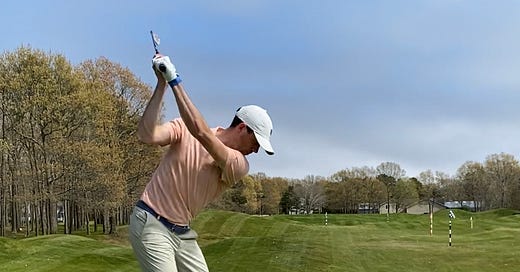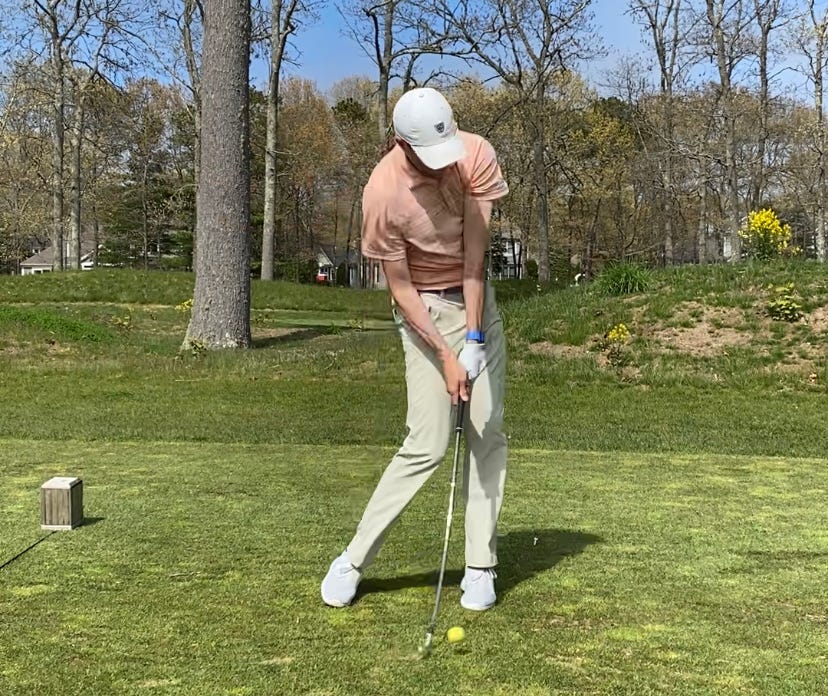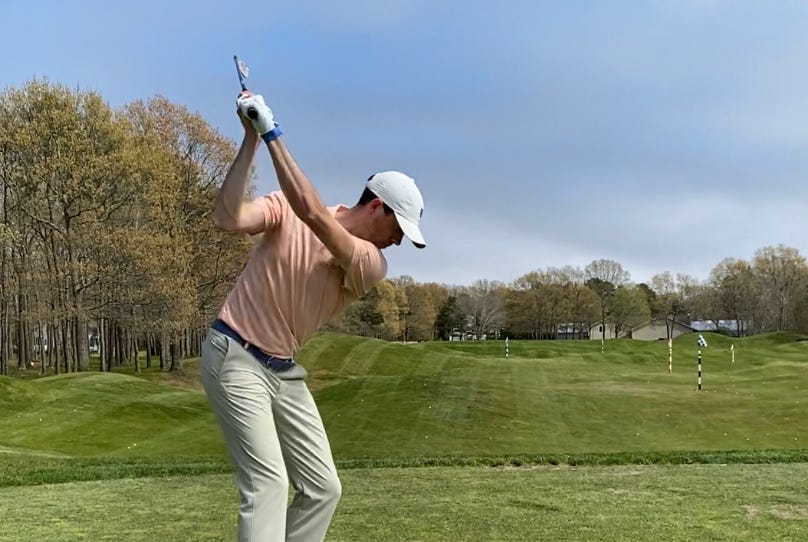I’d argue the invention of Youtube and subsequent explosion of golf content on the platform was the single greatest “equalizing” moment in golf history. Before you could search for “how to not slice the ball” on Youtube and get a million different versions of the same answer (“don’t come over the top!”), you had to either purchase a golf instruction book (not always easy to learn from pictures and text) or go see a local teaching professional (not always accessible and often costly) to get the answers you were looking for. Video on the internet brought instruction in the form of professional’s slow motion swings and eventually “Youtube coaches” to anyone who had an internet connection.
My formative years in golf were pre-Youtube. My first lessons came from my parents, the golf magazines my Stepdad had delivered to the house, and the infrequent lessons I would take with the teaching professionals at my home club. I didn’t video my swing on the range or have any kind of tech gadgets that would provide instant feedback on each and every swing I made. My swing was more or less home grown and I relied completely on the feedback of ball flight to determine what I was doing wrong.
Most importantly, I started playing golf with little to no understanding of the WHY behind each movement in the golf swing. A coach may have told me to perform this movement or that movement, but never was it explained to me why I should be doing it in that particular way.
I first started using Youtube to look at touring professional’s golf swings when I was a freshman in college in 2007. Y’all may remember Konica Minolta being the sponsor of the super slow motion swings that CBS would show a couple of times per round back in the day. I started watching as many of those as possible (especially those of Tiger’s during the Hank Haney years) and trying to mimic the positions he would get himself into. I still had NO IDEA why any of those positions mattered … I just figured if I could get into those positions like them, then I could hit it like them.
My swing changed from this long, loopy, inside-takeaway-and-across-the-line flowing swing to a shorter, laid-off, more rotational swing my first couple years of college. I started to consistently get the club into really good “down-the-line view” positions I’d see on Youtube, but I could never figure out the proper weight shift and sequencing required to put myself into a great impact position like Tiger or Adam Scott.
I was in a constant battle trying to find the next great move on the internet via these slow motion swings … and it led to some inconsistent years early in college. My college coach, Bob Molt, was less concerned with the technical elements of the swing and more helpful in getting us prepared to PLAY the game, which was great for me because I had fallen into the trap of playing “golf swing” my freshman and sophomore year. I still struggled with that malady my junior and senior years, but he got through to me enough to help me score better (despite battling a constantly changing swing).
The next eight years saw my swing improve little by little as I started to gain a slightly better understanding around why I needed to swing a certain way. I didn’t have a coach from the day I left college until early in 2021, so everything I learned was done via the internet in one way or another. 99% of the swings I took in an attempt to make changes were done inside an apartment, not actually hitting a ball (not a bad thing by the way … less focus on results). I wasn’t playing a ton but I was learning a lot … and it translated into on course improvements when I did get a chance to play.
The swing I ended up with during my first “comeback” year in 2019 saw me with a closed clubface in the backswing, very little shift of weight onto my back foot (and often little turn back), and a violent rotation through with my body to square the club face at impact. It would result in me tilting backwards too much at impact and hitting a high, floaty shot with nearly every club in the bag, especially the wedges. There was nothing “penetrating” about the way I hit the ball and my miss would tend to be weak right. When I timed things well, I played well. When my timing and sequence was bad, I hit the ball frustratingly bad. It got especially ugly when I was nervous and everything in the swing happened a little quicker.
That swing stuck around post the baby-hiatus (2020 through April of 2021), and THAT is the golf swing I first shared with Dom Azzopardi, the legend who is now helping me to rebuild my golf game. I reached out to him via Skillest, an extraordinary app that allows everyday players to connect with some of the best coaches in the world and take lessons through video asynchronously. A couple of things stood out about Dom. First, he had experience coaching professionals, including a top-50 player in the world (Lucas Herbert), but ALSO spent a lot of time teaching rising juniors and good, but not great players working to take their game to the next level. Second, he is an Aussie and has ties to my Mum’s and grandparent’s neck of the woods so I felt a kinship there. Third, he isn’t just a swing coach, but a golf coach. He was going to be able to help me out in all facets of the GAME, not just the technical components of the swing. And last (but certainly not least), he is just a good dude who truly cares about his students and their successes and he’ll go out his way to help however he can.
When Dom and I started working together in April of last year, we set out on a journey to neutralize some of the bad tendencies I played with (massive closed club face, poor impact position) and build a swing that would consistently fit into what we call “parameters” or the upper and lower bounds of where the swing should be on any given day.
We also spent time reflecting on WHY I needed to work on certain moves. A good example of this is the concept of weight shift. Pre-Dom, I basically just lived on my front foot throughout the whole swing and had very little weight shift. My thought was, “well, if I stay forward, then I don’t need to worry about the potential inconsistencies of moving back off the ball and then back through it”. Dom helped me understand that by not moving back off the ball and staying in my right glute longer during the backswing, I had nowhere to really go and I was constantly going to battle being at or behind the ball at impact, which was always going to create that inconsistent, high, floaty shot.
Over the past year, we’ve worked to get the club face a bit more open/neutral on the backswing (forcing me to cover the ball a bit better to hit it straight), shift my weight back and off the ball on the backswing, leading the downswing with my body turn versus relying on the arms, posting up on the left leg and turning around it, and keeping the club low to the ground post impact.
Add in a number of other small nuances and my golf swing is drastically different from what it used to be. My ball flight now borders on too low versus too high and my misses tend to come from hitting the ball TOO well and going long. All very good things coming from where I was twelve months ago …
A good example of the resulting changes came on the par 3 twelfth hole at Foxborough Country Club during the US Open Local Qualifier (documented in detail here). At 180-ish yards and playing into a steady headwind with a back pin, I historically would have been happy to just hit the green and two putt for par. I likely would have taken 5-iron out knowing the wind was going to have a major impact on the shot and I would have aimed 20 feet left of the hole preparing for the shot to get up in the air and fall off weakly to the right. With my new ball flight however, I was confident enough to play a tight little draw with a 6-iron that would land 20 feet short of the flag and hopefully release a few feet, leaving myself a makeable birdie putt. On that day, I pulled it off to perfection and hit a low boring shot that fell about a yard left of my target and settled just under the hole. I simply didn’t have that shot into the wind back in 2021 (or at any other point in my career for that matter) and to be able to trust it in a tournament was a good litmus test for how far I’ve come.
It is easy to look back on the changes in hindsight and say “damn, that was so simple, why couldn’t I have done it before”? But in reality, struggling through those changes piece by piece and learning the ins and outs of why the right move matters and what the alternative “wrong” moves can negatively affect is what actually improved my golf game. If I had just “gotten it” right away, I never would have had the ability to diagnose my own issues on the fly. As soon as things went bad on the course (which of course they always do), I would be lost. Being armed with a more intimate knowledge of my action is a powerful confidence booster and an advantage I believe I have over the younger generation of golfers who seemingly come out of the womb just “getting it”.
So what’s next in the process of creating the most consistent and repeatable swing possible?
For one, reps. I need more purposeful practice time ingraining the moves I know are correct. Ensuring constant check ins (both myself via video and with Dom) are happening to keep the swing within those parameters we’ve defined will be critical going forward. I’d like to also add a little more length and flow to the backswing and do a better job of getting into my right side and staying there longer before making a more consistent transition into my front foot. These are minor tweaks that will generate more consistency in the long run.
From there, we are looking at figuring out how to hit all the shots I need using the framework we’ve built. Taking the structure you see the last swing in the video at the top and learning how to hit it through all nine key windows (High, Medium, Low | Cut, Draw, Straight) and at different speeds.
I likely need to add a little distance to my game to compete at the highest of high levels, but that will come slowly through a consistently improving swing, improving flexibility, and a bit more muscle (the last two of which I’m also working on off the course). I’m certainly not going to get caught up in distance as a core priority because A) I may not be long but I hit it long ENOUGH; B) The way I play the game is far more strategic and thoughtful than many of the power players out there today, and I am not interested in fundamentally changing the way I play because of a sudden increase in distance and; C) I’m not going to overhaul my swing again just for the sake of distance … I will be dancing with the one who brought me as they say.
I’ll keep providing updates on new swing thoughts and big changes Dom and I make to both my swing and the other parts of my game. Make sure you subscribe to catch all of the goings on!





Share this post